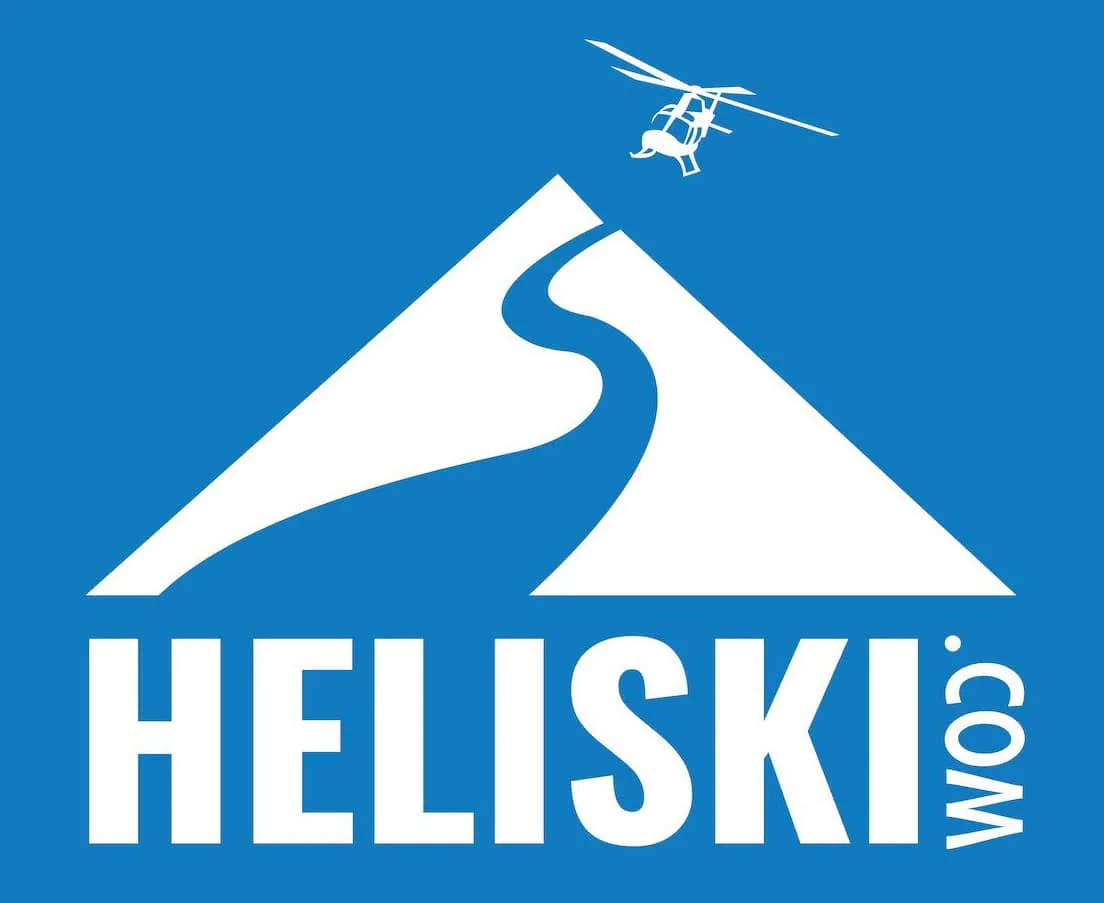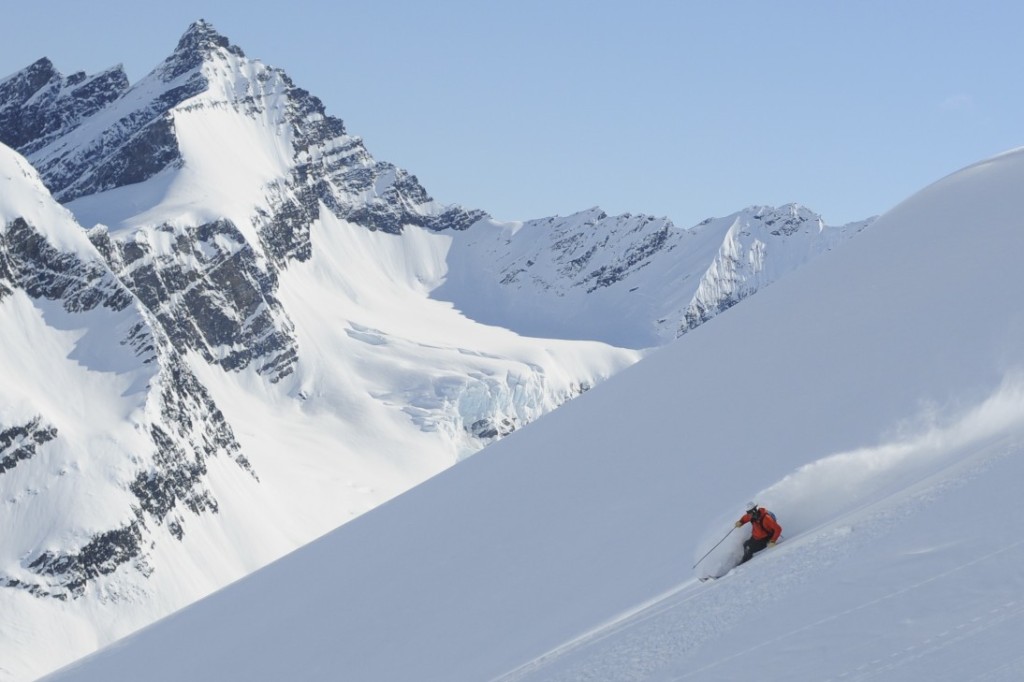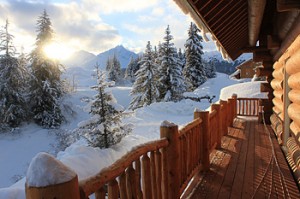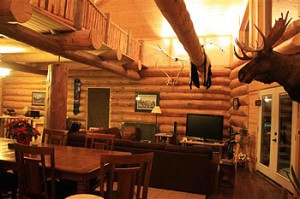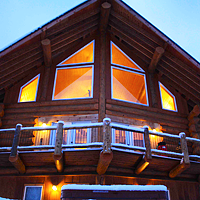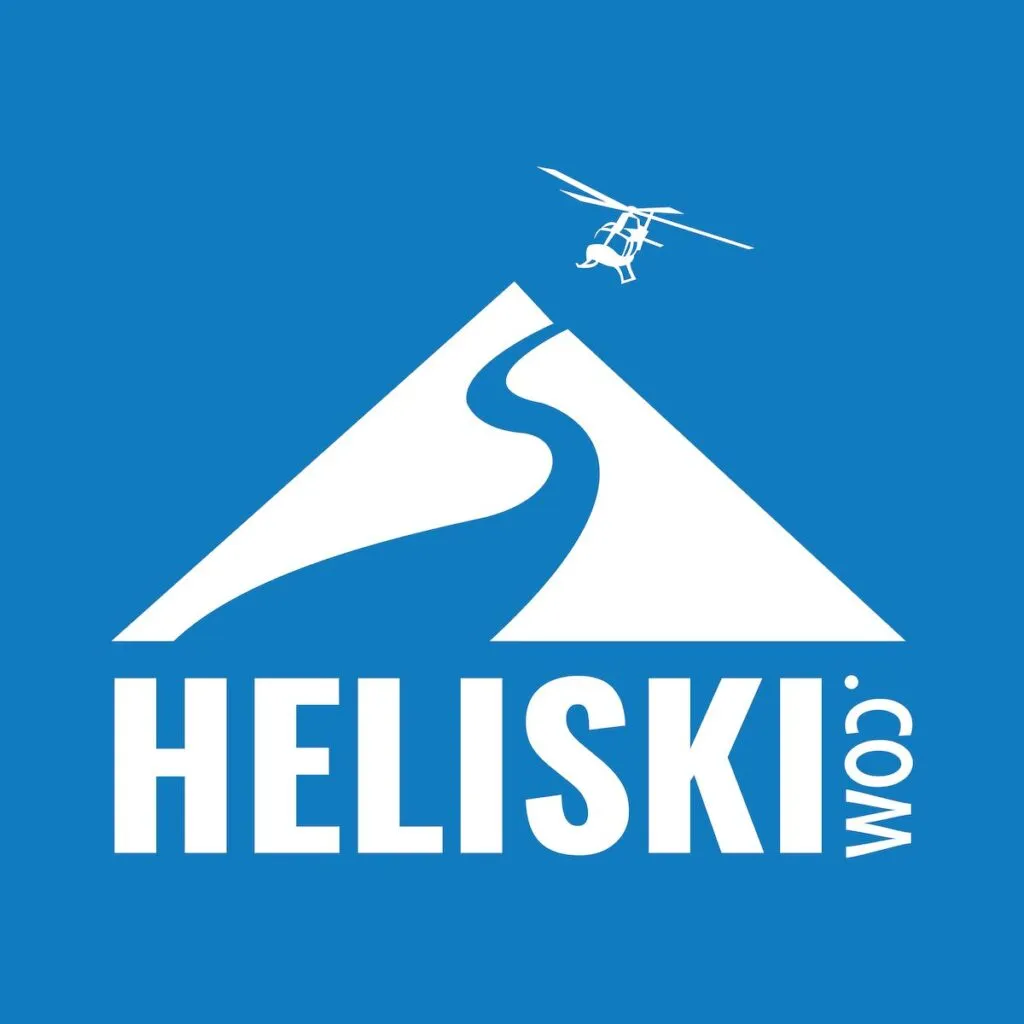Black Ops Valdez Heli-Skiing – HELISKI.com Interview
Tom: My first question is really deep. [Laughs] What’s the history Black Ops Valdeez Heli-Skiing?
Tabatha: [Laughs] Well do you want the short story or the long story? First off we built the lodge, Robe Lake Lodge. That was the first step. Our ultimate goal was to provide a more personal all inclusive “Alaskan” type experience for skiers and snowboarders in Valdez. My husband worked for one of the other ops for several years after we moved here in 2004, and so we saw the type of product that was already being offered. Some of the ops at the time were shady, and the clients were getting dropped off at hotels in town until their next ski day, not really much offered for down days…you could tell a lot of the clients had higher expectations for their Valdez heli skiing experience. That was the niche we hoped to fill.
My husband had a construction business in the summers and I worked two full time jobs for many years to make it happen. We opened the lodge in 2009 year-round, to also accommodate summer visitors, but our real dream was to open our own Valdez heliskiing op. We did try to team up with a couple of other operators to offer lodging to their clients, but it just didn’t materialize. That also motivated us to take action and move forward with the heliski business. We had a couple of snowmachines already, and bought a couple of vintage snowcats that work great, so we started out offering snowcat and snowmachine skiing and tours with lodging packages. That got us off the ground, and after a couple of years we were ready to add the heliskiing into the mix.
Tom: I highly recommend this Black Ops Valdez heliski porn:
Tom: And so how did your partner Aaron get involved?
Tabatha: (Laughs)…another long story…Alaska is really like a small town even though it’s such a big state. So we ended up staying at the Knik River Lodge in the summer of 2012 for a couple of nights and talked to the owner for a while. Some of the TGR crew had stayed with us earlier that spring while filming The Dream Factory, and they also had a crew out of that area for some time as well. So in talking with the lodge owner he told us about this guy Aaron Ollivier, and his then heli op, the Valdez Heli Experience. He said he’d be a good guy for us to reach out to and see if we could team up somehow. So that’s how the whole thing started with partnering up.
As for Aaron’s heliskiing op history, he started out heli skiing in Canada, and then got turned on to Alaska and skied with Valdez Heli Camps for a while. He tried to buy out VHC, but well, let’s just say that didn’t go as planned. VHC went out of business, so he ended up getting a bum deal out of it and decided to start his own heliskiing op, which turned into Valdez Heli Experience. He only ran that for a short season in 2012, then we started our talks over the phone. He came up in 2013 to ski with us and see how we operate, and we got to know each other a lot better. It just seemed like we had the same vision for what could and should be a great heli skiing experience out of Valdez. After that we decided to basically merge our companies and partner up and it’s been great. Aaron is a successful entrepreneur, so he has a lot of experience to draw from business wise, and a lot of contacts that he’s made over the years, so he’s really been a great partner to have. Plus he is totally stoked on Valdez heli skiing, so that is always great to have someone that is super enthusiastic about your business as a partner.
Tom: Cool. So Black Ops started out doing sleds, and cat skiing?
Tabatha: Yeah, my husband started out doing sled skiing as a down day option for the operation he was working for about 8 years ago, that was Valdez Heli Ski Guides. He also did some other stuff like firearms shooting with clients when the ships couldn’t fly. He worked for them for 7 seasons I think, then we bought the cats after we built the lodge and started doing our own thing, so that was the winter of 2010-2011 if I remember right. Josh has a degree in Parks, Rec, Tourism and Commercial Recreation Management, so that’s his background anyway.
Tom: So do you operate from Robe Lake Lodge? And where is that exactly?
Tabatha: We actually have our base of operations at 16 mile of the Richardson Highway. The lodge is at mile 6, so it’s really close, only about a 10 minute drive from the lodge. We’ve got DNR and BLM permits for heli skiing, and cat skiing, and a few more permits for staging areas or landing zones up on Thompson Pass. Our cat terrain is actually huge; we can basically run from tidewater Valdez to mile 45 of the Richardson Highway, so that’s pretty cool. And we bought a bunch of stuff from ABA after they closed down, so we dubbed our base at 16 mile Keystone Village and have a lot of plans to make that a really great spot for our clients and staff starting this season. Yeah, I guess we’re pretty spread out when I list it all out like that. It’s really great though because we’ve got a buffer from the other ops, but we’re still in a great location to base the heli from.
Tom: Huh. Alright, so then you’ve got a BLM permit which you can also heli in, no problem?
Tabatha: Yeah. I mean, most of our terrain is actually on State of Alaska DNR land, but it’s great to have the BLM permit too so there’s less restriction for where we can fly. Basically we don’t have to be so careful to avoid the BLM zones because we’re permitted to fly there too.
Tom: Cool. How big is the area tenure or whatever?
Tabatha: Um, well it’s the whole Chugach, you want acres? (laughs) It’s a huge area…
Tom: Oh.
Tabatha: So our snowcat permits are good right now until 2017, but the heli skiing permits are basically renewed annually.
Tom: Is it different up there? Like can you drop people off in the Rendezvous area H2O, and the Valdez Heli-Ski Guides area?
Tabatha: Yeah, so the terrain is all public lands, so yeah, all the ops can operate in the same areas.
Tom: So it’s free-for-all?
Tabatha: You know it’s different than other places in the world because the Chugach is so vast. Really, there’s no reason for the operators to be right on top of each other, it just doesn’t make sense from an operational standpoint when there’s soooo much terrain. So I wouldn’t describe it like a free-for-all because for the most part the ops will stick to areas closer to their own base.
Tom: Close to home, yeah.
Tabatha: Yeah, for the most part, but you can go wherever. If you have a DNR permit then you can go anywhere on the state land, and with a BLM permit you can go anywhere on those lands, so that is really most of the area around where we operate. We just try to keep it professional and respectful with the other operators and if we’re going to an area that’s near their base, we’ll let them know, and vice versa. You know, there’s some well-known classic lines out there that everyone wants to ski, and we can take you there, it’s not off limits just because it’s in the “back yard” of another operation. I think some of the other ops may try to misrepresent that though.
Tom: That’s interesting. But everybody probably stays close to home because it’s cheaper to fly, right?
Tabatha: Exactly.
Tom: Yeah, in fact I remember…I skied with Rendezvous [Alaska Rendezvous Guides] I think we could see the parking lot at almost every run.
Tabatha: Oh, really? Wow.
Tom: Yeah, I mean, we stayed really close.
Tabatha: Huh.
Tom: Yeah. You’d have lunch, you go right back up to the next run. Plus they had this run called Cry Babies, because they would take people there for the first run to make sure they could hang, right?
Tabatha: (Laughs)
Tom: And people would be bitching about it, and then they’d take them off, you know, depending on their skill level.
Tabatha: But you can stay on Cry Babies all day long, right?
Tom: That’s right. And yeah, you get some groups lapping on Cry Babies…. I’m sure everybody’s happy.
Tabatha: [Laughs] Some of the runs we do we can see the whole harbor and the whole sound, like “From Summit to the Sea”, they have some great views. So you know that is one of the cool things about our base location, is that we kind of have the best of both worlds. I mean we’re easy access to the Pass, but we can also fly towards town depending on the weather.
Tom: Yeah. So are you a believer in the Blue Hole that Rendezvous [Alaska Rendezvous Guides] is always talking about where you get better weather up on the pass and therefore you ski more days?
Tabatha: Yes and no. I mean, there are a number of locations that tend to clear out quicker after weather, Rendezvous is one, but also the Tsaina, our base location at Keystone Village and Robe Lake all tend to get the blue holes. At least they seem to clear out faster than most other areas of the range, probably the topography, more or less…
Tom: So you charge by the Hobbs [helicopter flight hour]. That’s unusual in BC but is that catching on more in Alaska?
Tabatha: I don’t know that it’s catching on, but we like it. It’s really transparent, different from number of run programs or vertical feet which can be skewed or tallied in such a way as to benefit the operator and not the client. So to oversimplify, a Hobbs meter is really similar to a taxi cab meter. My husband likes to say “you pay to fly up whatever you ski down”.
Tom: I like that. You know, as a marketing guy I appreciate all the different pricing models, but that cost base is the one that I think makes the customer feel best.
Tabatha: It definitely makes the most sense to us, and a lot of our clients really like the structure. It also allows the client to have more input on where their money is being spent. I mean, say they’ve always wanted to ski XYZ peak, but it’s a little farther away than we’ve been skiing, if they want to pay the extra Hobbs to get there, we can do it.
Tom: Um, and so it’s difficult I think on the other hand for people to figure out how that compares, right?
Tabatha: Totally. And we’re learning that when customers are calling it’s taking an education. It takes time to explain what Hobbs is, when it’s being spent or used, things of that nature. But generally, we average one Hobbs hour a day. That’ll typically give you five to six runs, but I have seen up to eight runs when the groups were kept really tight.
Tom: Okay, so cat backup, I know I did one day in a cat up there during a storm, and if it was not the worst day of my life – its right up there.
Tabatha: Yeah…visibility?
Tom: You can’t see anything. And the snow was like setting cement!
Tabatha: Yeah, sometimes it can be pretty bad.
Tom: So do you have trees? You have runs that can be done on a whiteout?
Tabatha: Yeah, we have a lot to choose from. We’ve got alpine areas when the weather is good and then we have spruce and alder trees that help for definition when the weather and visibility are not good. We can pretty much operate along 40 miles of highway and pipeline access, so there are lots of options. I’d guess that we have the largest area for cat skiing of any operation in Alaska. One of our favorite spots is on a mountain called Sugarloaf closer to town. We’ve had some great pow days over there, and the terrain is fun for a variety of skill levels. Some steeper areas with cliff drops, some pillows, some tree skiing and some mellow pitches too.
Tom: Yeah. That’s cool. And I’m guessing same thing with your sleds.
Tabatha: Sort of. I mean, we can get to tree skiing for those bad vis days with the sleds, but there’s even more areas that we can access with snowmachines than the cat, just because of the type of machine. What really plays into that is the logistics of the group. If there’s a larger group, the snowcat makes the most sense because we can transport people more efficiently to maximize the skiing for everyone. Alternately, if there are only a few people on a certain day, and the weather’s not that bad, they might be better off doing some sled bumps and get to some terrain that could be a little more challenging. Although they might have to wait for their friends to get shuttled up, so there’s a few things for us to consider before we make the call on which way to go. We have lots of other down day activities that we can do to. Shooting is a popular one, especially with folks from other countries.
Tom: You know, I remember getting out of the chopper on a place where it wasn’t big enough for us to put our skis on at the same time. We had to take turns. And then I looked around in all directions and I could not tell which way we were going. It was that steep. I couldn’t get over it.
Tabatha: [Laughs] Yeah, I suppose Valdez is known for that type of terrain through magazines and movies, it’s definitely out there. But there’s lots of more mellow terrain too, and I guess when I say mellow, I don’t mean beginner, just not extreme. You know there’s so much terrain, you don’t have to be an extreme or pro skier to ride in Valdez, there’s lots to choose from for a variety of skill levels. I hear from a lot of people that don’t think they can come ski here because they’re not pro, but that’s totally not the case. But I think part of the fun for me, and actually for a lot of clients, is getting out of the heli, getting the rotor wash in your face, and looking down like, “Holy crap, where are we going?”
Tom: [Laughs] Yeah, right. Don’t drop your gloves! I think that’s one of the coolest things when they just get up to the edge, tilt, and go straight down the fall line. I mean, that’s got to be as good a ride as what we’re getting on skis.
Tom: I thought the sled thing sounded like a good deal. How does the price compare from sled to cat to heli?
Tabatha: Its $300 a day to go sled skiing or cat skiing, and we’ll usually make the call on which mode of transportation based on the size of the group, weather, snow conditions, logistics. Whatever makes the most sense…and we’ll discuss the options with the clients too and see what’s going to work for everyone.
Tom: That’s cheap.
Tabatha: Yeah, not too bad.
Tom: So how about the lodge/cabin? Tell me the setup there. It looks really nice.
Tabatha: Yeah, the lodge is great. We’ve got a separate website for that, RobeLakeLodge.com. We’re open year round and we’ve got a great view overlooking Robe Lake and mountain views in pretty much every direction. Even got to see some really sweet Northern Lights from the hot tub one night. It’s not huge, but that’s kind of the nice thing about it, it’s really a comfortable place for our guests to base their trip out of, lots of Alaskan and ski related décor, big screen TV, great food…
Tom: I’m curious about your thoughts on avalanche danger in Alaska versus BC. Do you think it’s any greater?
Tabatha: Wow, that’s hard to answer. There are so many factors that contribute to avalanche danger, and safety, so it’s difficult to compare. I think Valdez is unique in its snowpack, and unique in a good way. We have a maritime snowpack that can stick to some pretty steep slopes, and will maintain stability. But the biggest thing that I attribute toward avy danger or safety is experience. We recruited some heli skiing veterans through the closure of a couple of the other operators, so even though our heli operation is fairly young, our guide team is really a stellar collaboration of experience, both in heli skiing throughout the world and specifically to Valdez. So that’s really cool. You know we’re also becoming members of US HeliSki to get on board with where the industry is going. I think more regulation is coming, and we want to be at the forefront and not get ambushed by all kinds of new procedures, so we’re really making an effort to take our procedures and protocols to the next level…I think I side stepped the question though (laughs).
Tom: Okay, so another Alaska versus BC question…Why is it that you do only five or seven really long runs in a day? Is it because of the way you ski one at a time and you’re sort of traversing all over? Like on a good day in BC you can do 15 or 17, they’re shorter, I know.
Tabatha: So I haven’t ever heli skied in BC, so I’m not sure how the program works over there, but the runs here can be pretty long. 3000-5000 vert is pretty common, which can be kind of long for some people. It probably has a lot to do with the whole logistics of moving groups around; keeping safe distances from other skiers, maybe there’s a different way of doing things there? I know I’ve seen some pics with like 15 ski tracks all stacked together down a slope, and we definitely don’t operate quite like that, we usually spread out the groups a bit more. We try not to hit the same LZ more than once a day. Skiing one at a time is standard for Valdez, so maybe that takes longer, yeah, I’m not really sure what the exact answer is, but all of those factors come into play.
We can do 15 runs in a day on a good day too, especially with good skiers, and later in April when there’s longer fly days. But in general we try not to overwork the clients. We’ve got clients skiing a full week, so generally they want to pace themselves a bit. I think the demographic has changed a lot over the past 10 years too. It seems like the amount of skiing that we get in a day is enough for most clients, the runs are long, and so it’s a solid day of skiing out there. I guess that’s another cool thing about running with Hobbs time, because if everyone out there is strong and wants to keep skiing, we can do a few more runs if everyone is down for that. And if it looks like weather is coming in for the next couple of days, we’ll run a longer day and burn more hours while we can. But to do 15 runs you’d burn 2 or 3 Hobbs, so…
Tom: Yeah, I like the idea of only hitting one LZ a day. That’s cool.
Tabatha: That’s one of the ways we differentiate ourselves from other operators. We don’t put you on the same landing zone five times in a day.
Tom: So how are you doing your marketing?
Tabatha: Right now we are mostly through our website and social media. We’ve got a pretty good following on Facebook (like) and Instagram, Twitter (follow) , stuff like that. We have our website, and run some online marketing campaigns, and then we have a newsletter that we’ve been trying to pump out about once a month, building our mailing list. And we’ve actually had a lot of business turn up from word of mouth through the industry, our involvement with TGR for The Dream Factory, stuff like that, and we get quite a bit of local Alaskan business just from living here year round and talking to people. I think our name is starting to be better known in Anchorage and Fairbanks for sure.
Tom: You know, you may not want to hear it but I’ll often try to talk somebody out of going to Alaska. If they’ve never been heli skiing in Canada or Alaska, or if they’ve never been heli-skiing, I’d say, you know, that’s probably not the first place to go.
Tabatha: You’re right; I don’t want to hear that! (laughs) Seriously though, there really is terrain for lots of ability levels, it’s not all extreme. Probably the weather would be one factor to consider when comparing Alaska versus other places, but this year has been crazy weather just about everywhere, so hey….
Tom: Yeah right? So we heard all about the huge avalanche that closed off the road in and out of Valdez, so how did that affect you guys?
Tabatha: You know the media blows it up, Valdezians are pretty tough, it takes a lot to get us worked up, but it was pretty hairy there for a few days. The Damalanche…that’s what Valdez dubbed it since it was essentially an avalanche that became a dam…anyway our heli base area at mile 16 of the Richardson Highway was pretty much ground zero for that whole mess. The avalanche occurred right down the road, and the water that was backed up due to the snow dam was super close to flooding out our cabins that we just put there in October. My husband and I and the kids had all gone to Anchorage on Thursday, and the avalanche happened on Friday, so we got stuck there for 3 nights before we got on the ferry back to Valdez. But while we were there we were getting all these reports, and at one point we were told that our cabins were completely submerged, so we were waiting for them to all float down the river, pretty stressed about that, you know…But as it turned out they stayed dry through the whole thing. They had to wait about 5 or 6 days before they could start clearing the snow, then it only took them 4 or 5 days and they opened the road back up…the water got awful close though. There are a few videos on YouTube that show the water and the avalanche and our cabins are right there in the footage.
Tom: (Laughs) Wow, that’s crazy. Well I think that’s all the questions I had for you.
Tabatha: Cool, well thanks so much for taking the time to talk to me!
Tom: Alright, great talking to you. Cheers.
